Asymmetrical Flow Field Flow Fractionation for Investigating Intermolecular Interactions of Multifunctional Polymers
LCGC Europe
Describes how asymmetrical flow field flow fractionation (AF4) can be used to characterize intermolecular interactions in multifunctional polymers used in drug delivery.
Asymmetrical flow field flow fractionation (AF4) has great potential for characterizing intermolecular interactions, such as complexation and aggregation, in multifunctional polymers. High molar mass aggregates or polymer–drug complexes are separated with low or no destruction by shear forces. AF4 combined with light scattering detection leads to information on the scaling properties of these species. A particular advantage of this method is the filtering effect of the membrane, which enables quantitative characterization of the complexation. Complexation and encapsulation properties of dendritic materials are important for medical and pharmaceutical development of drug delivery systems.

Aggregation, complexation and encapsulation are important processes in the development of drug delivery systems for biomedical and pharmaceutical applications. Dendritic polymers are promising materials for such applications because of their extremely broad number of functionalities, which can be modified arbitrarily (1). They also have threedimensional architectures with a high number of peripheral groups that contain different cavities within the dendritic scaffold (Figure 1).
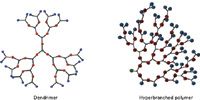
Figure 1: Schematic representation of two types of dendritic polymers. Dendrimers are synthesized stepwise and have a globular, perfectly branched structure formed by dendritic and terminal units. Hyperbranched polymers are the product of a one-pot reaction leading to statistical type of branching with a number of linear together with dendritic and terminal units.
Dendritic polymers have been intensively investigated for their potential to transport bioactive molecules and metal ions (2–4), and also as artificial enzymes (5), biomimetic structures (6) and templates for nanoparticles (7). Higher generation dendrimers that are modified to obtain a soft core and a hard shell can be used as dendritic boxes for guest molecules (8). Furthermore, polymers with a hydrophobic core and hydrophilic shell can carry hydrophobic substances under physiological conditions (9). The formation of dendritic complexes with guest molecules promises long-term drug delivery. However, the encapsulation and release are dependent on the type of modification of the endfunctionalities. In all these applications biocompatibility and non-toxicity should be seriously considered and this is often achieved by modifying with sugar, polyetheleneglycol or oligo-peptide units. For example, polyglycerols with a core-shell structure can carry paclitaxel and doxorubicin molecules, which are used in the cancer therapy (4). However, the encapsulation properties are often investigated using model guest molecules, such as Rose-Bengal, because they cost less and are easier to detect (10,11). By varying the concentration, temperature or pH value it is possible to control the release of the bioactive substances.
Reliable investigation of these complex structures is essential but not easy for various reasons. Light scattering or microscopy techniques deliver only average values on sizes. Big aggregates could be easily destroyed by shear forces when using size exclusion chromatography (SEC) or are too big for separation and size determination using this technique. Qualitative determination of complexes by ultraviolet-visible (UV-vis) measurements does not lead to precise results because of their chemically complex coreshell architectures. The quantitative characterization of encapsulation and complexation of model substances can be made by liquid chromatography (12,13), spectroscopy (14) or electrophoresis (15). In most of the cases, UV-vis of the absorption shift of the guest molecules after complexation is used in batch (16) or coupled to SEC (12). Both methods are limited: UV-vis does not lead to correct results because of the very complex chemical structure of the polymer carrier. The separation of the complex by SEC could lead prejudicially to strong interactions with the column material.
The separation of polymer complexes or aggregates leading to information on their distribution by size and complexation capacity is essential for their later medical use. Therefore, a gentle separation technique with reduced interaction is required. Asymmetrical flow field flow fractionation (AF4) has the potential to meet all these requirements. AF4 separates the sample along a thin and long channel, in which a laminar flow drives the molecules or particles. The interplay of both diffusion and cross flow field leads to the distribution of the molecules within the laminar flow according to size, density or surface properties, leading to their separation (17).
AF4 has been used to successfully separate biopolymers (18), nanoparticles (19), proteins (20) and viruses (21). Recently, in the field of biocomplexes, characterization of the distribution of triglycerides and cholesterol in plasma proteins was reported (20, 22). The potential of AF4 for complex characterization is huge.
In this work our recent developments in the characterization of dendritic biocomplexes by AF4 will be demonstrated to investigate the aggregation of dendronized biomolecules and of the quantitative determination of guest molecules in a dendritic complex. Both topics are based on dendritic structures with a significant number of end functionalities which are modified with oligosaccharides.
The dendronization of a linear polymer chain leads to high concentration of functional groups along the linear backbone. In contrast to dendrimers, where dendrons are coupled to a core and the size and functionality of the molecules are limited, dendronized linear structures enable the engineering of a portfolio of nano-objects varying in length, branch point frequency and dendron generation. This huge functionality is suitable to control complexation and to tune aggregation by varying the conditions within the physiologically relevant values (23). The effective control over functional activity needs clarification of the conditions influencing the aggregation, that is, the concentration, generation number and the pH value. The determination of the aggregation mass and size distribution, as well as shape analysis, were possible by AF4.
The same parameters are responsible for the encapsulation and release properties of the dendritic host. However, the amount of the complexed guest molecules in these systems should be determined considering their size, which could be in strong contrast to the host. Additionally, the stability of the complexes could be limited. These facts call for hyphenation of techniques allowing simultaneous, fast and smooth complex quantification. In this work a simple method to determine the non-bounded guest molecules by filtration through the AF4 membrane and calculation of the size of the complex by fractionation in the AF4 channel is demonstrated.
AF4 Experimental Conditions
All AF4 measurements were performed on an Eclipse 3 system (Wyatt Technology Europe, Dernbach, Germany). A poly(tetrafluoroethylene) (PTFE) channel spacer was used. The thickness of the channel was 350 µm and the channel dimensions were 26.5 cm length and 2.1–0.6 cm width. The membranes used in the accumulation wall and filtration device had different molecular weight cut-offs (MWCOs) of 5 kDa and 10 kDa and were made of regenerated cellulose. Flows were controlled with an Agilent Technologies 1200 series isocratic pump (Agilent Technologies, Wilmington, DE,s USA) equipped with a vacuum degasser. The detection system consists of a variable wavelength UV-Vis detector (UV) (Knauer, Berlin, Germany) tuned at 550 nm, an RI-detector Dn 2010 (WGE Dr. Bures, Dallgow-Doeberitz, Germany, λ = 620 nm, 25 °C) and a three-angle laser light scattering detector (MiniDAWN from Wyatt Technology, Santa Barbara, CA, USA). The UV detector was connected to the cross-flow outlet to determine the amount of free dye. The channel flow rate was maintained at 1.0 mL/min for all AF4 measurements. Samples were injected during the focusing/relaxation step with 0.2 mL/min during 2 min.
For dye filtration the focus flow was set to 3 mL/min for 20 min. The fractionation of the complex within this measurement followed in elution mode with linear cross flow gradient from 2 mL/min to 0 mL/min in a period of 20 min. For the determination of the molar mass of the complex focusing at 1.5 mL/min focus flow over a time period of 2 min and elution under a linear cross flow gradient from 2 mL/min to 0 mL/min for 20 min was performed. In the same way the separation and detection of the aggregates of dendronized polymers was performed. However, exponential cross flow gradient was applied.
For dye@polymer complex characterization deionized, UV-treated and ultra-filtrated pure water containing 0.02% sodium azide (v/v) was used. For the characterization of the aggregation of dendronized polymers, an additional pH adjustment in NaNO3 buffer solution was performed.
Aggregation of Dendronized Polymers
The dendronized glycopolymers are composed of a linear maleimid (MI) backbone at which lysine-dendrons are coupled with a nearly complete modification of every MI unit. The dendrons are in three generations, whereas the number of the end functionalities increases with the generation number. The end-functionalities of the dendronized polymers are then completely modified with maltose (Figure 2) (24). The Maltose-modified end-functions lead to pronounced aggregation. The aggregation ability is amplified at higher concentrations in water. The generation number strongly influences the aggregation too because when the generation number increases the amount of end groups for each of the molecules increases substantially.
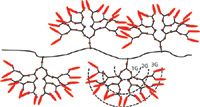
Figure 2: Schematic representation of dendronized, maltose-modified polymer of third generations.
This property is also dependent on their concentration in a water solution. Additionally, the aggregates are very sensitive towards pH changes and this property should be easy to adjust for their future application conditions. The investigation of the aggregates and their distribution can be easily performed by AF4. Other common techniques, such as SEC, are not suitable because the molar mass of the dendronized polymers is extremely high. Another difficulty is their strong affinity to the stationary phase because of their strong polar functionality. Additionally, shear forces formed during elution through the column could destroy the aggregates and cannot lead to reliable data. In contrast to this the shear forces in AF4 are strongly reduced. The lack of stationary phase reduces undesirable interactions and allows for easy change of the pH of the eluent. This enables systematical aggregation study at variable conditions (pH, concentration and generation number of the dendrons).
Systematic investigation of concentration, pH value and generation number showed that the first generation dendronized copolymer does not show significant aggregation, whereas the third generation starts to aggregate at very low solution concentrations (Figure 3).
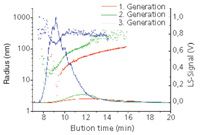
Figure 3: Light scattering signal at 90° of AF4 separation and Rg/elution volume plot of three generations of the dendronized polymers at pH 3.5 and c = 1 mg/mL.
Further analysis of the size of the molecules using static and dynamic light scattering indicated a strong dependence of the size of the species on the generation number. The pH dependence of the radius of gyration and the hydrodynamic radius of the aggregates is clearly visible in Figure 4, where the behaviour of the third generation dendronized MI is shown. Whereas big aggregates are formed at acidic conditions, at pH value of 7 the aggregation is strongly reduced and is increasing again at higher pH.. Further interpretation of the molar mass and radius of gyration combined with AFM measurements showed that stiff, laterally ordered aggregates are formed under these conditions.
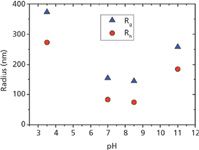
Figure 4: pH dependent aggregation of the third generation dendronized MI at c = 0.5 mg/mL. Rg (z-average) determined by AF4-MALLS and was Rh determined by dynamic light scattering.
Complexation Characterization of Dendritic Glycopolymers
Oligosaccharide-modified hyperbranched poly(ethylene imine) (PEI) possesses strongly reduced toxicity compared to the non-modified PEI and high ability to carry drug molecules (25). Dendritic polymers with an oligosaccharide shell can therefore form host-guest systems with dye molecules as models system to study drug delivery ability (Figure 5).
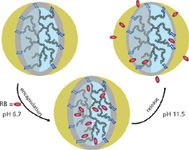
Figure 5: Schematical representation of encapsulation and release of RB by PEI-Mal.
Core-shell molecules of hyperbranched PEI as a core and oligosaccharide shell were mixed with Rose Bengal (RB) resulting in dye@PEI-Mal complexes (25, 26). Their complexation properties are strongly dependent on the pH value which was found by the shift of the UV-vis absorbtion maximum of RB: a typical indication for interaction of the dye. Commonly, the separation and determination of the free dye from the complex is performed by means of dialysis, ultra-filtration or ultracentrifugation followed by a UV-vis analysis in batch. However, for this specific system these methods provide nonquantitative information about the complexation capacity as a result of different possible chemical moieties binding the dye such as PEI or maltose, which does not allow for reliable calibration of the UV-vis signal shift of the RB. Therefore, we considered the ultra-filtration effect of AF4 as a suitable alternative for this quantification. During the focusing phase ultra-filtration is taking place, filtering the species smaller than the cut-off of the membrane (Figure 6) (26). During this step the non-bound Rose Bengal is flushed out from the channel while the complex of Rose Bengal and PEI-Mal remains inside.
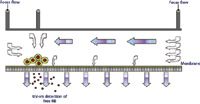
Figure 6: Filtration of free RB and separation from the complex RB@PEI-Mal.
The quantitative analysis of the free dye filtrated through the membrane requires few optimization steps. The fact that RB interacts with the membrane of regenerated cellulose could appear as a significant problem during the experiments. Our membrane tests showed that the modification of the membrane with 250 µg RB is sufficient for the formation of stable, layer allowing for quantitative analysis over several days. Under those conditions the calculation of the filtrated dye was made by calibration of a UV-vis signal from a detector connected to the waste line of the cross flow. Further parameters, for example, membrane material, molecular weight cut-off and stability of pure RB and RB@PEI-Mal complexes, were investigated and verified, showing high reproducibility of the performed measurements as shown in Table 1.

Table 1: Recovery test for the quantitative determination of RB calibration (UV-vis detection).
The development of the quantitative determination of free RB allowed us to determine the complex capacity of the PEIMal molecules. Figure 7 represents the data obtained for different mixtures of RB and PEI-Mal. The amount of the RB in the complex was determined in two ways:
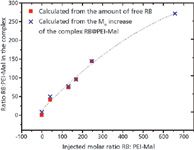
Figure 7: RB complexation capacity of PEI-Mal determined by calculating the free RB (red symbols) and by the molar mass increase of the complexes (blue crosses). RB withMn = 1018 g/mol and PEI-Mal with Mn = 200,500 g/mol.
- Subtracting the free RB detected after filtration during the focusing from the RB in the injected mixture.
- Increasing the molar mass of the complex compared to the pure PEI-Mal, which was determined by AF4 separation in the channel.
The development of the molar mass distributions depending on the PEI-Mal:RB ration in the mixture is shown in Figure 8. The complexation studies based on both those methods are in very good agreement. The capacity of the complexes was found to reach 271 RB guest molecules for each host PEI-Mal. This value was supported by additional experiments using other ultra-filtration techniques.
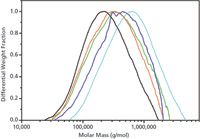
Figure 8: Differential molar mass distribution of free PEI-Mal (black) compared to complexes RB@PEI-Mal with initial ratio of 1:41 (red), 1:96 (green), 1:246 (blue), 1:657 (cyan) PEI-Mal:RB.
Conclusions
The AF4 technique is suitable for comprehensive analysis of intermolecular interactions in multifunctional polymers as aggregation and complexation with guest molecules. Effective molar mass determination of these polymers is possible as a result of reduced interactions with channel material leading to full size separation. The investigation of the aggregation behaviour of big polymers is advantageous, mainly because of weak shear forces during the separation and the possibility to couple this technique to size sensitive detectors. Furthermore, the ultra-filtration effect of AF4 can be effectively used for quantitative determination of the amount of complexed small guest dye molecules in core-shell polymers. This feature of AF4 has a big potential for upgrading to separation and quantification of drugs encapsulated in polymers and makes the AF4 technique very promising for the analysis of drug delivery systems.
Albena Lederer received her PhD in Physical Chemistry of Polymers in 1999 from Max-Planck-Institute of Polymer Research and University Mainz. She has been leader of the Polymer Separation Group at IPF Dresden since 2007. The main focus of her research is molecular properties of dendritic and multifunctional polymers and the development of new separation methods for branched polymers.
Susanne Boye joined the Polymer Separation Group at IPF Dresden in 2006 after studying Chemical Engineering at the University of Applied Sciences in Dresden. She is finishing her PhD thesis devoted to the separation of branched and functional polymers using FFF and alternative chromatographic approaches.
References
1. B. I. Voit and A. Lederer, Chem. Rev., 109, 5924–5973 (2009).
2. A. W Bosman, .H. M Janssen and E. W. Meijer, Chem. Rev., 99, 1665–1688 (1999).
3. U. Boas and.P. M.J Heegaard, Chem. Soc. Rev., 33, 43–63. (2004)
4. M. Caldéron et al., Adv. Mater., 22, 190. (2010).
5. J. Kofoed and J. L. Reymond, J. L. Curr. Opin. Chem. Biol., 9, 656-664 (2005).
6. S Hecht and J. M. J.Frechet, Angew. Chem.-Int. Edit., 40, 74-91 (2001).
7. R. M. Crooks et al,. Acc. Chem. Res., 34, 181-190 (2001).
8. J.Jansen, E. M. M. Debrabandervandenberg and E. W. Meijer, Science, 266, 1226–1229 (1994).
9. C. J. Hawker, K. L. Wooley and J. M. J. Frechet, J. Chem. Soc.-Perkin Trans. 1, 1287–1297 (1993).
10. A. D'Emanuele and D. Attwood, Adv. Drug Deliv. Rev., 57, 2147–2162 (2005).
11. S. Onclin, J. Huskens, B.J. Ravoo, D. N. Reinhoudt, Small, 1, 852–857 (2005).
12. M. A. Quadir et al., J. Cont. Rel., 132, 289–294 (2008).
13. S. Rozou, S. Michaleas and E. Antoniadou-Vyza, J. Chrom. A, 1087, 86–94 (2005).
14. Zhao et al., J. Phys. Chem. B. 113, 14172-14179 (2009).
15. A. Helle, et al., J. Chrom. A, 1178, 248–255 (2008).
16. K Kono et al., C. Polymer, 49, 2832–2838 (2008).
17. J. C Giddings, Sep. Sci. Technol.. 19, 831–847 (1984).
18. M. van Bruijnsvoort et al., J. Chromatogr. A, 925, 171 (2001).
19. A Zattoni, et al.. J. Chromatogr. A, 1216, 9106–9112 (2009).
20. R. N. Qureshi, W. T.Kok and P. J. Schoenmakers, Anal. Chim. Acta. 654, 85 (2009).
21. B. Roda et al., Anal. Chim. Acta, 635, 132–143 (2009).
22. D. C. Rambaldi et al., Anal. Chim. Acta, 654, 64–70 (2009).
23.a) M.J.N.Junk et al., Macromol. Chem. Phys., 2011, 212, 1229-1235. b) R. Duncan and L. Izzo, Adv. Drug Deliv. Rev., 57, 2215–2237 (2005).
24. D. Appelhans et al., Polym. Prep., 49, 590 (2008).
25. D. Appelhans et al., Biomacromolecules, 10, 1114–1124 (2009)
26. S.Boye et al., J. Chromatogr. A, 1217, 4841–4849 (2010)
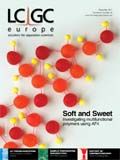
Retaining Talent in Field-Flow Fractionation: An Initiative
The authors present their motivation for establishing the Young Scientists of FFF (YSFFF) initiative within the FFF community.






